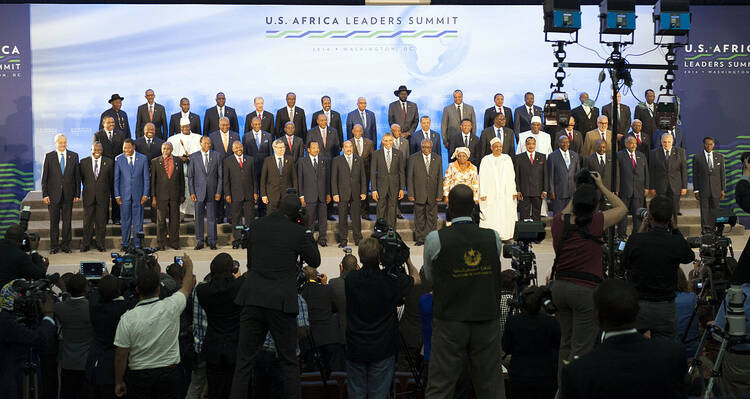Into Africa
President Obama probably hoped that his unprecedented summit with 50 African leaders, an effort to shore up relations with emerging African states, could be put to good public relations use, highlighting for a change some good news out of Africa. Indeed, there are positive developments to report: Six of the world’s 10 fastest-growing economies can be found in Africa; and by the summit’s close on Aug. 6, the heads of state were able to celebrate the announcement of $33 billion in new private investment.
Unfortunately, reality kept intruding on the grandstanding at the summit. Sierra Leone, with a per capita growth rate this year of 13.8 percent, could be lauded as an African tiger, but the Ebola crisis overshadowed any good news from West Africa. Protesters outside the summit properly reminded everyone that corruption and despotism on the continent remain matters of urgency. The signing in late July of a cease-fire agreement between Seleka, which is mostly Muslim, and anti-balaka (mostly Christian) antagonists in the Central African Republic should have been another cause for celebration. (See “Allowed to Hope?” 6/9.) But hope that this awful conflict could finally be drawing to a close was hit hard by realities on the ground as fighting between the two sides resumed even before the ink was dry on the truce.
This first-ever African summit marks a laudable recognition that this troubled part of the world is as filled with potential and youth as it is overburdened with poverty and problems. But Washington’s attention must remain patient and persistent if it is to be a true friend to Africa and not just another power lining up to extract riches from these developing states and their rising peoples.
Tortured History
Torture is back in the news. In early August the executive editor of The New York Times, Dean Baquet, announced the paper will use the word torture to describe practices like waterboarding, sleep deprivation and stress positions that the Times and other leading news outlets have in the past instead referred to as harsh or brutal interrogation techniques.
The editorial about-face came, not incidentally, ahead of the much-anticipated release of the Senate Intelligence Committee’s report on the Central Intelligence Agency’s detention and interrogation program in the years after the terrorist attacks of Sept. 11, 2001. The C.I.A. was given an opportunity to apply its black marker liberally to the 500-page executive summary before its public disclosure. But Senator Dianne Feinstein, the committee chair, has rejected the redactions, which she claims “eliminate or obscure key facts that support the report’s findings and conclusions.” She has asked President Obama, who approved the C.I.A.’s initial cuts, to restore key information. Until a compromise is reached, Ms. Feinstein will not declassify the report.
On Aug. 1, the day the report was set to be released, the president stated candidly, “We tortured some folks.” That much we have known for years, even if we have tried to minimize the sting of moral failure by calling it something else. People familiar with the report indicate that the congressional investigation found the use of torture more widespread, more brutal and less effective at gathering actionable intelligence than the C.I.A. had led the White House, its overseers and the public to believe. “We” might not have approved of this torture, but it was done in our name and purportedly in our interest. It is therefore our right and indeed our duty to know as much as can responsibly be disclosed about this dark chapter in U.S. history.
Evangelizing Rural Catholics
In recent years, the church has placed great emphasis on the new evangelization, seeking to renew belief and religious practice, especially among those who for whatever reason have drifted away from active or complete participation in church life. There is one segment, however, that has not received much attention—rural Catholics.
It is hard to believe that in a prosperous country like ours, there are still Catholics in poor rural communities in need of our pastoral care and concern. In a recent interview with Catholic News Service, Jim Ennis, head of the National Catholic Rural Life Conference, spoke of the need to care for those Catholics in the United States who live in rural areas, places that do not readily come to mind when discussing pastoral needs. Rural dwellers make up less than 20 percent of the U.S. population; but, as Mr. Ennis notes, people living beyond the cities and sprawling suburbs are still critical for the life of the church, and if we neglect them, we do so “at our peril.”
Additionally, Mr. Ennis emphasized the need for the laity to become more involved in ministering to fellow Catholics in rural areas, for without attention from clergy and laity alike, rural Catholics will feel like second-class citizens in their own church. Catholic Rural Life sponsors lay leadership programs to help scarce clergy minister to an important part of the Catholic family; and thanks to efforts like these, an important part of the church will not be left out.








